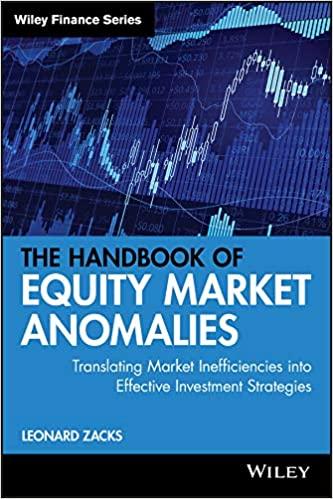Question
Risk is the exposure to the chance of an unfavorable event. There are two types of risk, unsystematic risk, and systematic risk. Systematic risk cannot
Risk is the exposure to the chance of an unfavorable event. There are two types of risk, unsystematic risk, and systematic risk. Systematic risk cannot be eliminated by diversification since systematic risk affects almost all assets to some degree. Unsystematic risk can be eliminated through diversification and the reward of taking risk is the risk premium. Total risk which is the sum of unsystematic risk and systematic risk is measured by standard deviation while systematic risk is measured by beta. The capital asset pricing model defines the relative risk of an individual asset as its contribution to the risk of a well-diversified portfolio.
Students will have the opportunity to calculate and discuss how changes in the general stock and bond markets could lead to changes in the required rate of return on a firms stock and examine risk as well as the cost of capital and its use in managing the financial structure of the firm.
During the last few years, Abiproffy Industries has been too constrained by the high cost of capital to make many capital investments. Recently, though, capital costs have been declining, and the company has decided to look seriously at a major expansion program that has been proposed by the marketing department. Assume that you are an assistant to Leigh Jones, the financial vice president. Your first task is to estimate Abiproffys cost of capital. Jones has provided you with the following data, which she believes may be relevant to your task.
- The firms tax rate is 25%
2. The current price of Abiproffys 12% coupon, semiannual payment, and noncallable bonds with 15 years remaining to maturity is $1,153.72. There are 65,000 bonds. Abiproffy does not use short-term interest-bearing debt on a permanent basis. New bonds would be privately placed with no flotation cost.
3. The current price of the firms 10%, $100 par value, quarterly dividend, and perpetual preferred stock is $116.95. There are 200,000 outstanding shares. Abiproffy would incur flotation costs equal to 5% of the proceeds on a new issue.
4. Abiproffys common stock is currently selling at $50 per share. There are 3 million outstanding shares. Its last dividend (D0) was $3.12, and dividends are expected to grow at a constant rate of 5.8%. Abiproffy beta is 1.2; the yield on T-bonds is 5.6%; and the market risk premium is estimated to be 6%. For the over-own-bond-yield-plus-judgmental-risk-premium approach, the firm uses a 3.2% judgmental-risk premium.
5. Abiproffys target capital structure is 30% long-term debt, 10% preferred stock, and 60% common equity.
To help you structure the task, James Brown has asked you to answer the following questions.
- What types of capital should be included when you estimate Abiproffys weighted average cost of capital (WACC)?
- Explain in words why new common stock that is raised externally has a higher percentage cost than equity that is raised internally as retained earnings.
Step by Step Solution
There are 3 Steps involved in it
Step: 1

Get Instant Access to Expert-Tailored Solutions
See step-by-step solutions with expert insights and AI powered tools for academic success
Step: 2

Step: 3

Ace Your Homework with AI
Get the answers you need in no time with our AI-driven, step-by-step assistance
Get Started


